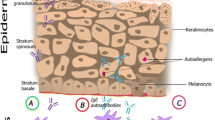Abstract
Expression of the high affinity IgE receptor (FcεRI) on eosinophils has recently been reported. This led us to evaluate FcεRI expression on eosinophils in atopic dermatitis (AD). Double immunofluorescence stainings with an anti-FcεRI monoclonal antibody (mAb) and a polyclonal antieosinophil cationic protein (ECP) antibody were performed on lesional biopsy specimens from patients with AD and from patients with bullous pemphigoid (BP) as controls. In AD and BP lesions, 77% and 70% of eosinophils expressed FcεRI, respectively. However, the intensity of FcεRI staining in AD was much stronger than in BP, suggesting upregulation of FcεRI expression on eosinophils in AD. In addition, the eosinophils infiltrating AD lesions were stained strongly with anti-CD23 mAb and anti-IgE antibody. At the sites of mite patch testing in AD, FcεRI-, CD23- and IgE-positive eosinophils were observed to the same degree as in the lesions, and a considerable number of mite antigen-bearing eosinophils were detected. FcεRI and CD23 were both upregulated on the skin-infiltrating eosinophils in AD and bound IgE molecules.
Similar content being viewed by others
References
Aubry J-P, Pochon S, Graber P, Jansen KU, Bonnefoy J-Y (1992) CD21 is a ligand for CD23 and regulates IgE production. Nature 358: 505–507
Bacon K, Gauchat J-F, Aubry J-P, Pochon S, Graber P, Henchoz S, Bonnefoy J-Y (1993) CD21 expressed on basophilic cells is involved in histamine release triggered by CD23 and anti-CD21 antibodies. Eur J Immunol 23: 2721–2724
Bieber T (1994) FcεRI on human Langerhans cells: a receptor in search of new functions. Immunol Today 19: 52–53
Bieber T, Ring J (1992) In vivo modulation of the high-affinity receptor for IgE (FcεRI) on human epidermal Langerhans cells. Int Arch Allergy Immunol 99: 204–207
Bieber T, Salle H de la, Wollenberg A, Hakimi J, Chizzonite R, Ring J, Hanau D, Salle C de la (1992) Human epidermal Langerhans cells express the high affinity receptor for immunoglobulin E (FcεRI). J Exp Med 175: 1285–1290
Capron M, Capron A, Dessaint J-P, Torpier G, Johansson GO, Prin L (1981) Fc receptors for IgE on human and rat eosinophils. J Immunol 126: 2087–2092
Capron M, Kusnierz JP, Prin L, Spiegelberg HL, Oblaque G, Gosset P, Tonnel A-B, Capron A (1985) Cytophilic IgE on human blood and tissue eosinophils: detection by flow microfluorometry. J Immunol 134: 3013–3018
Capron M, Grangette C, Torpier G, Capron A (1989) The second receptor for IgE in eosinophil effector function. In: Fridman WH (ed) Structures and functions of low affinity Fc receptors. (Chemical immunology, vol 47) Karger, Basel, pp 128–178
Capron M, Truong M-J, Aldebert D, Gruart V, Suemura M, Delespesse G, Tourvieille B, Capron A (1991) Heterogeneous expression of CD23 epitopes by eosinophils from patients. Relationships with IgE-mediated functions. Eur J Immunol 21: 2423–2429
Conrad DH (1990) FcεRII/CD23: The low affinity receptor for IgE. Annu Rev Immunol 8: 623–645
Coronimas M, Mestre M, Bas J, Verdaguer J, Valls A, Romeu A, Buendia E (1993) CD23 expression on B-lymphocytes and its modulation by cytokines in allergic patients. Clin Exp Allergy 23: 612–617
Costa C, Rilliet A, Nicolet M, Saurat J-H (1989) Scoring atopic dermatitis: the simpler the better? Acta Derm Venereol (Stockh) 69: 41–45
Czech W, Krutmann J, Schuöpf E, Kapp A (1992) Serum eosinophil cationic protein (ECP) is a sensitive measure for disease activity in atopic dermatitis. Br J Dermatol 126: 351–355
Fujita Y, Rubinstein E, Greco DB, Reisman RE, Arbesman CE (1975) Antigen-antibody complexes in or on eosinophils in nasal secretions. Int Arch Allergy Appl Immunol 48: 577–583
Gounni AS, Lamkhioued B, Ochiai K, Tanaka Y, Delaporte E, Capron A, Kinet J-P, Capron M (1994) High-affinity IgE receptor on eosinophils is involved in defence against parasites. Nature 367: 183–186
Hanifin JM, Rajka G (1980) Diagnostic features of atopic dermatitis. Acta Derm Venereol Suppl (Stockh) 92: 44–47
Hartnell A, Walsh GM, Moqbel R, Kay AB (1989) Phenotypic markers on human eosinophils. J Allergy Immunol 83: 192
Hubscher T (1975) Role of the eosinophil in the allergic reactions. 1. EDI — an eosinophil-derived inhibitor of histamine release. J Immunol 114: 1379–1388
Kägi MK, Joller-Jemelka H, Wünthrich B (1992) Correlation of eosinophils, eosinophil cationic protein and soluble interleukin-2 receptor with the clinical activity of atopic dermatitis. Dermatology 185: 88–92
Kapp A (1993) The role of eosinophils in the pathogenesis of atopic dermatitis — eosinophil granule proteins as markers of disease activity. Allergy 48: 1–5
Leiferman KM, Ackerman SJ, Sampson HA, Haugen HS, Venencie PY, Gleich GJ (1985) Dermal deposition of eosinophilgranule major basic protein in atopic dermatitis. N Engl J Med 313: 282–285
Maeda K, Yamamoto K, Tanaka Y, Anan S, Yoshida H (1992) The relationship between eosinophils, OKT6-positive cells and house dust mite (HDM) antigens in naturally occurring lesions of atopic dermatitis. J Dermatol Sci 3: 151–156
Maurer D, Fiebiger E, Reininger B, Wolff-Winiski B, Jouvin M-H, Kilgus O, Kinet J-P, Stingl G (1994) Expression of functional high affinity immunoglobulin E receptors (FcεRI) on monocytes of atopic individuals. J Exp Med 179: 745–750
Ra C, Kuromitsu S, Hirose T, Yasuda S, Furuichi K, Okumura K (1993) Soluble human high-affinity receptor for IgE abrogates the IgE-mediated allergic reaction. Int Immunol 5: 47–54
Suemura M, Kikutani H, Barsumian EL, Kishimoto T (1989) IL-4 and Fcε receptor II in allergy. In: Sorg C (ed) Cytokines regulating the allergic response. (Cytokines, vol 2) Karger, Basel, pp 18–36
Tanaka Y, Anan S, Yoshida H (1990) Immunohistochemical studies in mite antigen-induced patch test sites in atopic dermatitis. J Dermatol Sci 1: 361–368
Yasueda H, Saito A, Akiyama K, Maeda Y, Shida T, Sakaguchi M, Inouye S (1994) Estimation of Der p1 and Der f1 quantities in the reference preparations of Dermatophagoides mite extracts. Clin Exp Allergy 24: 1030–1035
Author information
Authors and Affiliations
Rights and permissions
About this article
Cite this article
Tanaka, Y., Takenaka, M., Matsunaga, Y. et al. High affinity IgE receptor (FcεRI) expression on eosinophils infiltrating the lesions and mite patch tested sites in atopic dermatitis. Arch Dermatol Res 287, 712–717 (1995). https://doi.org/10.1007/BF01105794
Received:
Issue Date:
DOI: https://doi.org/10.1007/BF01105794



